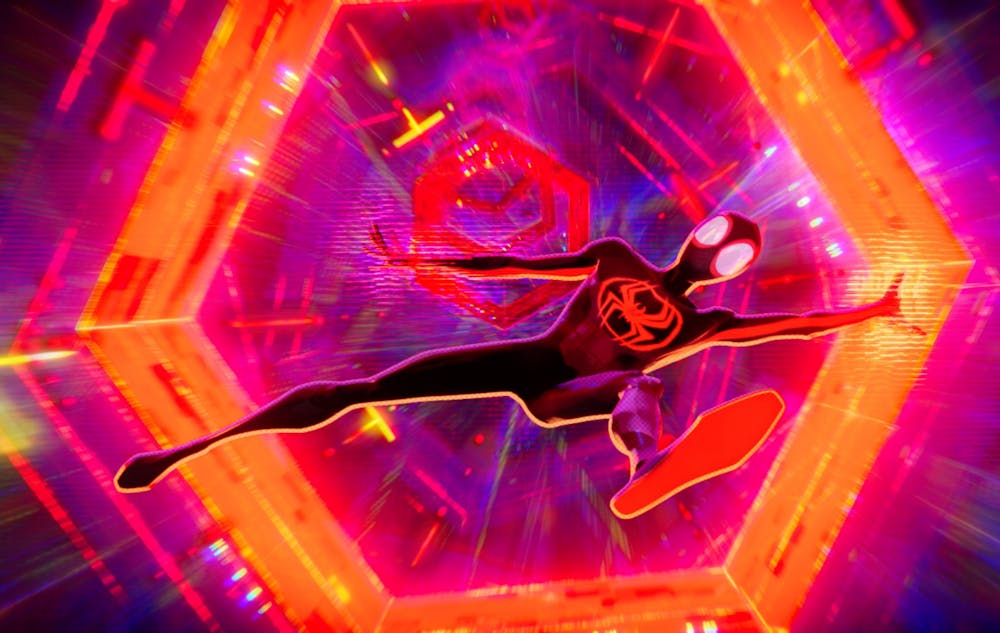When I saw “Spider-Man: Across the Spider-Verse” in theaters, one of the trailers before the picture was for Seth Rogen’s upcoming “Teenage Mutant Ninja Turtles: Mutant Mayhem.”
That film, the first “Teenage Mutant Ninja Turtles” film since 2016 and the first animated one since 2007, has a distinct visual style that combines two-dimensional and three-dimensional animation, much like both of the “Spider-Verse” films. And although visual development artist Kellan Jett said they weren’t necessarily “inspired” by those films, he made it clear they “opened the door for us to try something new.”
I don’t think that’s too far off the mark either. “Spider-Verse” has helped launch something of an animation renaissance, one where animators aren’t looking toward just Disney and Pixar for inspiration but instead experimenting with and producing some truly unorthodox styles. Case in point: “Puss in Boots: The Last Wish,” a sequel film that, for all intents and purposes, should not have been able to achieve a higher Rotten Tomatoes score than its predecessor.
But it did, and that’s due in large part to its willingness to explore visual territory that’s entirely different from anything the Shrek franchise has previously done. In turn, it rejected the style of animation that has dominated the media landscape since the original “Shrek” film came out in 2001 — that is, one inspired by the computer-generated animation Pixar’s been perfecting since “Toy Story” in 1995.
[Related: COLUMN: Swing, don't walk, to 'Spider-Man: Across the Spider-Verse']
Let me get something straight: there’s nothing inherently wrong with this sort of animation style. Several Pixar films rank among my favorite animated films of all time — “The Incredibles,” “WALL-E” and “Soul,” just to name a few. But, in the same way not every video game needs the picture-perfect, realistic graphics of “Red Dead Redemption 2,” not every animated film needs to look like a Pixar project.
When “Spider-Man: Into the Spider-Verse” released in December 2018, it grossed about $384 million against its $90 million budget. Not only that, it garnered critical acclaim and even won the Academy Award for Best Animated Feature, becoming the first non-Disney/Pixar film to do so since “Rango” in 2011. Simply put, it wasn’t just a success — it was a major success that studios knew they would be stupid not to capitalize on.
Similar to how the unexpected success of “Everything Everywhere All at Once” proved that audiences want weirder, more experimental films in the mainstream, “Spider-Man: Into the Spider-Verse” and its sequel proved audiences want unconventional, radical animation, too. “Puss in Boots: The Last Wish” was similarly successful.
And Pixar has been noticing, because how couldn’t it? With its 2021 film “Luca,” the animators took a different approach than they have before — the film was a challenge, not because Pixar animators have trouble creating realistic texture, but because director Enrico Casarosa made it a stated goal to make the film less realistic.
“The tools of the trade are getting better at capturing realism,” he said. “We wanted to work on stylization and beautiful shades and lyricism. So, that is the bit where we pushed the tools to do something that they don’t necessarily want to do.”
[Related: OPINION: There's more to movies than Marvel]
Both “Luca” and its follow-up, “Turning Red,” were influenced by Japanese animation such as that from Studio Ghibli. The end result is something of a remix of Pixar’s standard house style: visually, they’re still Pixar films through and through, but there’s an undeniable tinge of experimentation that differentiates them to the photorealism of “Soul” or the recent “Toy Story” films.
Sony Pictures Animation, the studio behind the “Spider-Verse” films, is by no means a small, indie underdog that’s violently shaking the system. But, it forcefully changed the status quo, and it made behemoths like Pixar pay attention. “Spider-Man: Into the Spider-Verse” and its sequel are both great films, but their effect on the industry will ensure their place in film history.
Joey Sills (he/him) is a junior studying journalism and political science.






